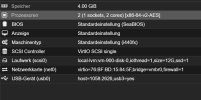Hi there
I am new to proxmox and no expert to linux at all. So please consider me a child that needs someone to take his hand...
I am using a USB device that is bound directly to a VM that runs openmediavault. Before that I had connected the device on linux directly to the pve as ZFS. In any case the write speed to that disk is only 21-23 MB/s. When I connect the USB Drive to my Windows Computer write speed is 100 MB/s ...
I have read the whole internet and found, there are several people facing this issue, but I could not find a way on my low level of experience to fix it.
Since I connected it both ways (direct USB bound) as SMB share and ZFS to the PVE direct - and speed is the same, I assume the way of connection may not be the issue...
My PM is on the latest NUC 13th generation.
I watched the status of the cores, the network and memory of the Openmediavault and before the PVE... there are no performance issues.
Network, cores and memory turn the thumbs and are bored.
Anyone out there taking my hand?
Thanks
LEM
I am new to proxmox and no expert to linux at all. So please consider me a child that needs someone to take his hand...
I am using a USB device that is bound directly to a VM that runs openmediavault. Before that I had connected the device on linux directly to the pve as ZFS. In any case the write speed to that disk is only 21-23 MB/s. When I connect the USB Drive to my Windows Computer write speed is 100 MB/s ...
I have read the whole internet and found, there are several people facing this issue, but I could not find a way on my low level of experience to fix it.
Since I connected it both ways (direct USB bound) as SMB share and ZFS to the PVE direct - and speed is the same, I assume the way of connection may not be the issue...
My PM is on the latest NUC 13th generation.
I watched the status of the cores, the network and memory of the Openmediavault and before the PVE... there are no performance issues.
Network, cores and memory turn the thumbs and are bored.
Anyone out there taking my hand?
Thanks
LEM



